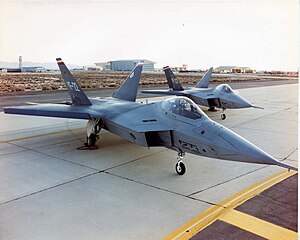Air Force Systems Command
| Air Force Systems Command | |
|---|---|

Lockheed-Boeing-General Dynamics YF-22 Advanced Tactical Fighters, 1990. The YF-22 was the last major weapons system delivered to Air Force Systems Command prior to its inactivation and merger into Air Force Material Command.
|
|
| Active | 1 February 1950 – 1 July 1992 |
| Country |
|
| Branch |
|
| Type | Major Command |
| Garrison/HQ | Baltimore, Maryland (1950–1958) Andrews Air Force Base, Maryland (1958–92) |
| Nickname(s) | AFSC |
| Insignia | |
| Emblem of Air Force Systems Command (1961–1992) |  |
| Emblem of Air Research and Development Command (1950–1961) |  |
The Air Force Systems Command (AFSC) is an inactive United States Air Force Major Command. It was established in April 1951, being split off from Air Materiel Command. The mission of AFSC was Research and Development for new weapons systems.
AFSC took on engineering functions which formerly resided in the Air Materiel Command (AMC), the Army Air Forces Technical Service Command (TSC), and the Air Technical Service Command (ATSC) as a separate research and development command in 1950. It incorporated Air Proving Ground Command in 1957. On 1 July 1992, AFSC and Air Force Logistics Command were merged to form the Air Force Materiel Command, located at Wright-Patterson Air Force Base, Ohio.
In the reorganization of 1961, Air Force Systems Command acquired the materiel procurement function from Air Force Logistics Command. It was re-integrated with Air Force Logistics Command in 1992.
The origins of Air Force Systems Command date at least to the establishment of the Airplane Engineering Department by the Chief Signal Officer, U.S. Army, on 13 October 1917 at McCook Field, Ohio. Re-designated the Engineering Division of the U.S. Army Air Service in March 1919, this organization carried out the research, development and testing of military aircraft, engines, airships and accessories. Renamed the Materiel Division of the newly established Army Air Corps in October 1926, it undertook the procurement, supply and maintenance activities of Army aviation.
American aviation development fell behind its European rivals after the mid-1930s when Germany started a continental arms race. The threat of war at the decade's end began to change the situation. During the late 1930s American industry spent over $100 million annually on aviation research. University grants grew and military personnel enrollment in science courses increased. Leaders of the Army Air Forces (AAF) were alarmed by many of the new weapons that would revolutionize air warfare which had emerged from foreign laboratories. Radar, jet aircraft (Messerschmitt Me 262, Fieseler Fi 103 (V-1 flying bomb)) and ballistic missiles (V-2 rocket) had all either originated or been perfected outside the United States. Congress greatly increased funds for R&D. Subsequently, the engineering function resided in the Materiel Command, the AAF Technical Service Command, the Air Technical Service Command, and the Air Materiel Command.
...
Wikipedia
